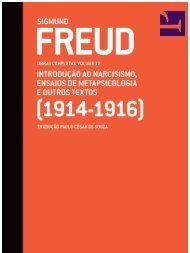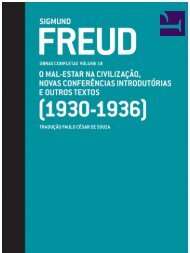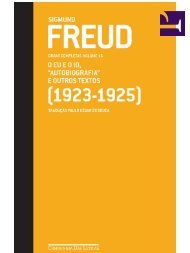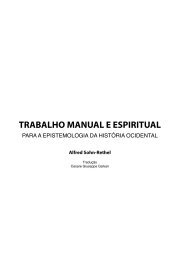Perversion the Social Relation
Perversion the Social Relation
Perversion the Social Relation
- No tags were found...
You also want an ePaper? Increase the reach of your titles
YUMPU automatically turns print PDFs into web optimized ePapers that Google loves.
Contamination's Germinations 189some drive, not simply as an expression of that drive, but as a channel towhich <strong>the</strong> unity or coherence that perversion disperses might have beendisplaced, where <strong>the</strong> particles can be maintained in some form of organization,be it more chaotic than linear. Psychoanalytically, <strong>the</strong> drive isassociated with <strong>the</strong> organism's relations outside itself, but as psychoanalysishas been taken up in literary studies, <strong>the</strong> drive has come to beconnected with narrative, which might seem a vantage point by which<strong>the</strong> impersonality of <strong>the</strong> drive is more clearly viewed. In fact, narrative'sjuxtaposition with <strong>the</strong> drive ends up obscuring <strong>the</strong> fact that <strong>the</strong>re is noindividual in ei<strong>the</strong>r narrative or <strong>the</strong> drive. And yet, narrative is inherentlysocial; <strong>the</strong> telling of stories is unavoidably embedded in our socialorganization, our relations to one ano<strong>the</strong>r. Thus my interest in thisessay is in how narrative's sociality could possibly work on a nonindividualistparadigm, and I suggest that for narrative to do so requiresperversion's partiality, dispersion. The drive provides a <strong>the</strong>ory or inevitabledetour through which we can work out <strong>the</strong> question of how <strong>the</strong>recan be perverse narrative. Contamination, deeply perverse itself, as <strong>the</strong>nonhumanist, nonindividualist paradigm of driven dispersion, presents<strong>the</strong> epigrammatic figure for my concern. To begin, <strong>the</strong>n, let us considernarratives of contamination and <strong>the</strong>ir work on or with <strong>the</strong> drive(s).In <strong>the</strong> postmodern canon, Don DeLillo's 1984 novel White Noise offers<strong>the</strong> most likely literary example of <strong>the</strong> culture of contamination; <strong>the</strong> featuredimpurity is <strong>the</strong> Airborne Toxic Event, which takes up <strong>the</strong> middlesection of <strong>the</strong> novel. 2 But <strong>the</strong>re's ano<strong>the</strong>r text that uncannily has almostexactly <strong>the</strong> same features as White Noise: an airborne toxic event, presentedby <strong>the</strong> protagonists in a first-person narration that emphasizes<strong>the</strong> quotidian, at times ventures upon meditation, or is interrupted by<strong>the</strong> media, with <strong>the</strong> specter of Nazism in <strong>the</strong> background and <strong>the</strong> Germansin <strong>the</strong> fore, and a narrative drive toward closure at <strong>the</strong> end of <strong>the</strong>day—be it sunset or nightfall. This text is Christa Wolf's Accident: ADay's News (1987). 3 Perhaps it was just what was in <strong>the</strong> air in <strong>the</strong> mideighties,but I think something more drives <strong>the</strong> convergence of <strong>the</strong>se twonovels' realization of contamination. What novel realization about <strong>the</strong>drive germinates in <strong>the</strong> convergence of <strong>the</strong>se two contaminations?There's little question, at first glance, that Jack Gladney, protagonist/narratorin Don DeLillo's White Noise, exhibits a strong deathdrive; it is easy to see his obsession with death, with who—he or his








